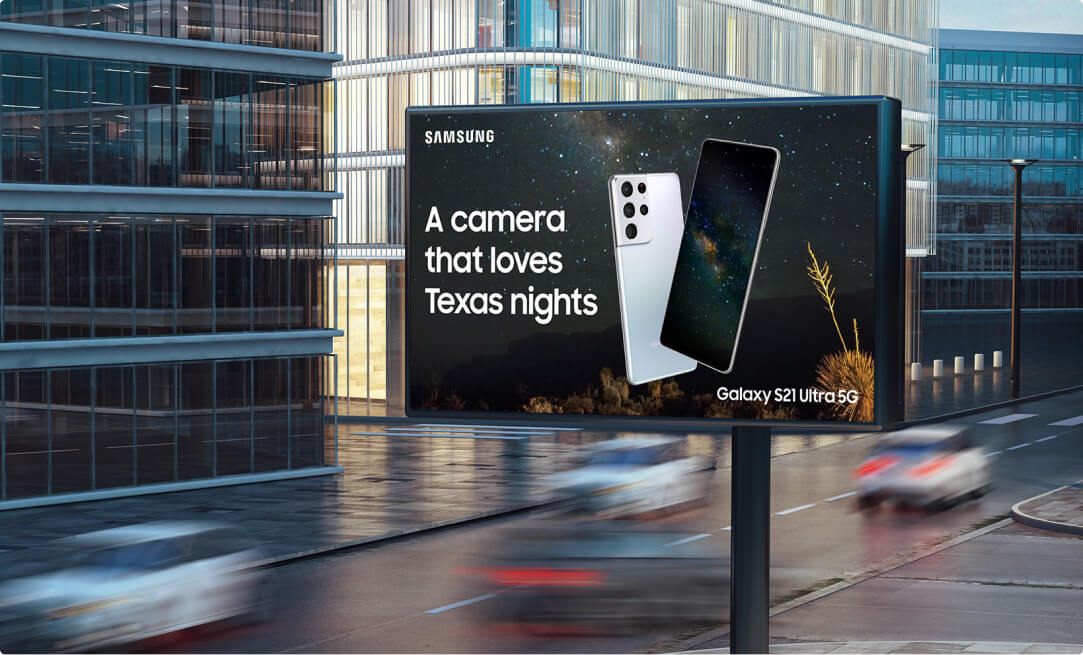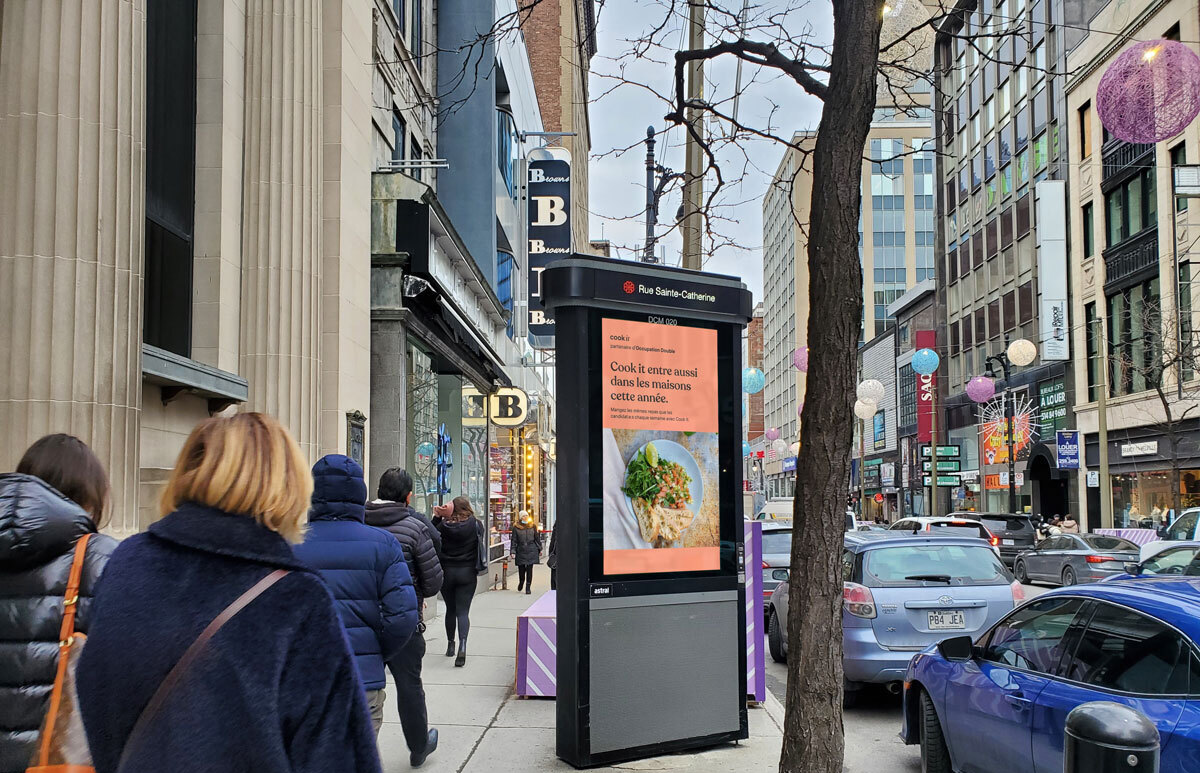Programmatic advertising is hardly a new concept for Montreal-based agency Fidelitix. Founded in 2015, Fidelitix works with brands and advertisers to manage all aspects of
Continue readingComment l’agence programmatique Fidelitix amplifie les campagnes de ses clients grâce à l’affichage numérique
La publicité programmatique n’est pas un concept nouveau pour l’agence montréalaise Fidelitix. Fondée en 2015, Fidelitix travaille avec des marques et des annonceurs pour gérer tous les aspects de leur stratégie de publicité numérique. Membre de 360.Agency, l’entreprise exploite la publicité programmatique et l’intelligence des données pour créer des campagnes efficaces qui atteignent les publics avec le bon message au bon moment.
Pour réduire l’écart entre la publicité en ligne et hors ligne, Fidelitix a commencé à introduire l’affichage numérique dans ses offres programmatiques. Nous avons rencontré Cynthia Bélanger, directrice du développement de produits chez Fidelitix, pour en savoir plus sur l’expansion de l’affichage numérique et sur le rôle que joue Campsite dans les stratégies médias de leurs clients.
Pourquoi s’étendre à l’affichage numérique?
En tant qu’agence qui se concentre sur les données et les progrès technologiques, l’expansion dans le monde de l’affichage dynamique programmatique était une étape naturelle pour continuer à répondre aux besoins des clients. Avec plus en plus de marques et d’agences qui adoptent des stratégies de marketing omnicanal pour atteindre les consommateurs, Fidelitix a commencé à intégrer l’affichage numérique programmatique dans les campagnes cross-média de ses clients.
L’affichage en général est un domaine nouveau pour de nombreux clients de l’agence, dont beaucoup sont de petites marques, des agences et des concessionnaires automobiles. Plus familiers avec la publicité numérique, les journaux et à la radio, de nombreux clients de Fidelitix pensaient que l’affichage était hors de portée. Selon Cynthia, ces marques et agences associent généralement l’affichage à d’énormes investissements, ce qui n’est pas nécessairement vrai avec la publicité programmatique. Comme l’explique Cynthia, démontrer comment les campagnes des clients peuvent être optimisées grâce à l’affichage numérique est un facteur clé pour amener les clients à adopter ce média. “L’affichage numérique est une extension si facile de n’importe quelle campagne que vous menez”, dit-elle, et les avantages à transmettre sont nombreux.
L’affichage dynamique offre une énorme visibilité grâce à sa capacité de d’augmenter le rappel des marques ainsi qu’une très grande portée. De nombreux clients de l’agence utilisent ce média pour optimiser les parcours de type “full-funnel”. Pour d’autres, comme la clientèle de concessionnaires automobiles de Fidelitix, l’affichage numérique est un moyen de promouvoir les ventes, souvent en conjonction avec des campagnes numériques. Cynthia donne l’exemple d’une marque qui diffuse des publicités via Spotify: un consommateur potentiel pourrait écouter un podcast via son appareil mobile et recevoir des publicités Spotify. Grâce aux capacités de géofencing mobile, ce même consommateur peut ensuite être reciblé avec des publicités numériques extérieures de la même marque au cours de la journée.
L’intégration de l’affichage numérique dans une campagne omnicanale présente également des avantages financiers. En termes de CPM, l’affichage numérique est un média rentable, un avantage pour les clients qui planifient leurs budgets publicitaires sur une base mensuelle. Il est également plus facile pour les petits annonceurs d’adapter leurs publicités utilisées en ligne au format de l’affichage numérique, ce qui permet aux clients disposant de budgets et de ressources limités de créer plusieurs publicités pour chaque canal.
La puissance de la publicité programmatique
Grâce à l’affichage dynamique programmatique, les clients de Fidelitix peuvent optimiser et étendre la portée de toute campagne numérique rapidement et efficacement. Comme nous l’explique Cynthia, l’affichage numérique programmatique permet à de nombreux annonceurs d’accéder à l’inventaire d’affichage à des coûts plus raisonnables par rapport à d’autres formes de publicité comme la radio, la télévision et la presse écrite. Les marques et les agences utilisent des fonctionnalités programmatiques telles que le géofencing mobile pour lancer des campagnes d’affichage dans certaines zones ciblées, et l’ajout d’un autre type de média comme le PDOOH leur permet d’atteindre des audiences avec des capacités de ciblage plus contextuelles. En fait, un concessionnaire automobile travaillant avec Fidelitix a créé une campagne très contextuelle utilisant un ciblage basé sur l’emplacement pour atteindre les audiences autour des emplacements DMV.
“Nos clients adorent la façon dont ils peuvent être contextuels avec l’affichage numérique. C’est très amusant de trouver ces idées avec eux”, déclare Cynthia. “Ils apprécient également le caractère tangible de l’affichage numérique par rapport aux impressions en ligne. Il y a quelque chose d’unique et d’excitant à voir sa marque sur un panneau d’affichage.”
Pour les concessionnaires automobiles, l’affichage dynamique présente une opportunité de se démarquer alors que le trafic reprend et que les consommateurs passent plus de temps dans leur voiture.
“L’affichage numérique est un excellent moyen d’augmenter la visibilité des marques tout en améliorant les possibilités de narration des concessionnaires automobiles. Les concessionnaires doivent s’impliquer dans les communautés pour réussir, et l’affichage numérique est un excellent moyen de transmettre le message et participer activement à faire rayonner la communauté. C’est également un excellent moyen d’impliquer notre client dans la création et le message de chaque campagne diffusée sur grand écran.”
Mike Chalut, directeur des médias chez 360.Agency
L’expérience avec Campsite
L’objectif de Fidelitix est de rendre la publicité programmatique accessible aux clients qui la trouveraient normalement intimidante ou moins accessible. En tant qu’agence numérique programmatique, l’introduction des clients dans le monde de l’affichage numérique programmatique est simple et directe grâce à Campsite. Pour Cynthia, utilisatrice de Campsite chez Fidelitix, trouver de nouvelles technologies pour aider les clients à faire passer leur message est une priorité. Campsite contribue au processus de planification des campagnes des clients, au téléchargement des publicités et à l’élaboration de propositions pour les marques et les agences.
Premièrement, Cynthia crée la proposition de campagne et partage le lien directement avec le client ou l’annonceur. Le client peut ensuite la personnaliser et l’adapter à ses besoins, par exemple en sélectionnant des emplacements et des panneaux d’affichage spécifiques. “Nous apprécions vraiment la façon dont l’outil vous permet d’enregistrer des propositions pour vos campagnes et de partager le lien avec les clients”, dit-elle. “Les clients peuvent regarder tout ce que vous avez inclus dans leur stratégie et choisir ce qu’ils veulent en termes d’emplacement tout en ignorant les écrans qui ne sont pas dans une zone de marché primaire.” Une fois que le client est satisfait et qu’il a approuvé la proposition, l’utilisateur peut directement convertir la proposition en une campagne, télécharger leurs publicités et lancer la campagne en quelques minutes.
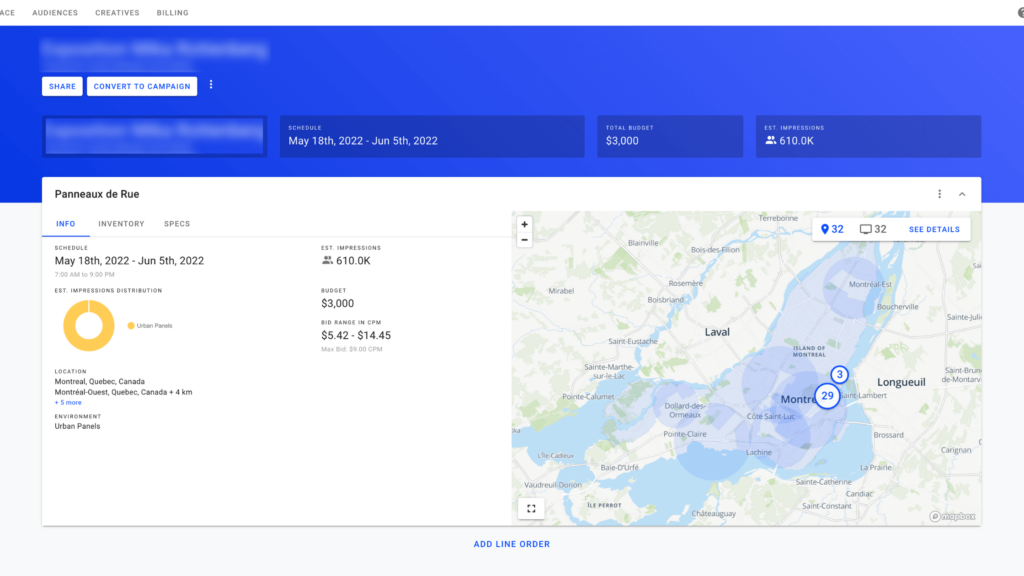
Fidelitix collabore également avec ses clients pour élaborer des stratégies telles que la répartition journalière et la planification budgétaire, en adaptant les campagnes en fonction de l’heure de la journée ou d’autres déclencheurs. Par exemple, une marque peut décider de maximiser son budget en lançant une campagne seulement pendant les heures de pointe du matin et de l’après-midi. Avec Campsite, l’utilisateur choisises paramètres et peut instantanément lancer des campagnes flexibles et personnalisées. L’agence mène en parallèle des stratégies en ligne et hors ligne, en utilisant DV360 pour la publicité d’affichage numérique et Campsite pour mener des campagnes d’affichage numérique avec les mêmes publicités qui ont été adaptés pour le canal.
En termes de facilité d’utilisation, Cynthia et l’équipe de Fidelitix apprécient le fait que Campsite soit une plateforme libre-service spécialement conçue pour l’affichage numérique. De la planification à l’exécution de la campagne, le processus est sans faille et très similaire aux plateformes publicitaires en ligne.
“Nous aimons le fait que nous puissions nous connecter à Campsite, définir des paramètres, modifier des campagnes et jouer avec la plateforme de manière complètement autonome tout en ayant le support de Campsite disponible si nous avons des questions. C’est complètement indépendant et facile à utiliser.”
Cynthia Belanger, directrice du développement des produits chez Fidelitix.
Lancer des campagnes d’affichage créatives et contextuelles avec Campsite.
Ouvrez votre compte maintenant ou prenez rendez-vous avec l’un de nos experts pour planifier votre prochaine campagne.
How Samsung’s programmatic campaign went big in Texas

Samsung was looking to increase brand awareness, consideration, and purchase intention for its Samsung Galaxy S21 smartphone in this booming region of the U.S. To increase exposure, the brand turned to Broadsign to leverage the power of out-of-home for its Texas campaign. Joining forces with Samsung’s agency Cheil, Broadsign helped develop a programmatic digital-out-of-home strategy that would target specific audience segments at scale.

The objective
Samsung wanted to track, measure, and get a better sense of DOOH’s impact on drive-to-store metrics. The objective was to target specific audience segments, leveraging mobile data signals, with high reach and frequency across multiple DOOH publisher networks, making this campaign a perfect candidate for programmatic execution.

The solution
The Campsite DOOH channel-specific DSP was used to plan and create the campaign in partnership with Cheil. To track and measure the DOOH campaign’s full-funnel impact, two other partners were included: MFour to measure brand impact and PlaceIQ for footfall traffic tracking.
MILLIONS OF QUALIFIED IMPRESSIONS DELIVERED
Thanks to Campsite’s scale, flexibility, and control, the campaign delivered highly-targeted impressions to on-the-go tech and photo enthusiasts at the most relevant times and places. Exposed devices were passed to the DV360 data marketplace for retargeting.
TARGETED AUDIENCE-BASED BUYS
Campsite’s audience targeting capabilities led to a more efficient media spend compared to traditional location-based buys, resulting in significantly stronger campaign reach and frequency.
SEAMLESS OMNICHANNEL EXPERIENCE
Audiences exposed to the DOOH campaign (identified via mobile device IDs) were reached with similar creatives across various online channels for additional reach and engagement, creating a seamless omnichannel experience.

The results
Positive Ad Recall
Programmatic DOOH was instrumental in the success of this campaign thanks to the short lead time and flexibility needed in the planning and execution phases.
Increased ad recall with
50%
of exposed audiences recalling seeing the ads
86%
of audiences found the ads likeable
67%
said the campaign gave them a more favourable opinion of the brand and product
Positive Impact on Brand Metrics
6%
lift in brand consideration
7%
lift in purchase intent
1.75x
lift in in-store visitation

2021 OMMA Award Finalist Campaign

“To execute a campaign of this magnitude, we needed a DSP that could deliver on ease of use and transparency – and Campsite performed above and beyond our expectations thanks to its numerous capabilities and capacity to streamline the DOOH-specific workflow. Furthermore, collaborating with Campsite’s team of programmatic digital-out-of-home experts meant seamless execution from start to finish.”
Keri Thomas, Media Supervisor at Cheil

Ready to get started with programmatic digital out-of-home?
Our team of experts is on hand to assist you with planning, execution, and post-campaign reporting.
Create interactive consumer experiences and measure OOH ad exposure with dynamic QR codes
The OOH industry is projected to grow in 2022 as consumers become more optimistic and spending begins to pick up. According to the latest insights report from the OAAA and Harris Poll Consumer Insights and Intent for Early 2022, 47% of consumers in major cities are noticing OOH ads compared to pre-pandemic levels. The study found that 85% of viewers think OOH ads are useful, with a further 42% saying they pay the most attention to ads that feature promotions or special offers.
As OOH comes back, there are some changes in trends that are occurring throughout the industry. QR codes are making a comeback thanks to their touch-free technology and ability to provide brands with measurable consumer data. In fact, one study found that the number of QR code coupons that will be redeemed by a mobile device in 2022 is expected to reach 5.3 billion – more than triple the 1.3 billion redemptions reported in 2017. With today’s consumers more accustomed to scanning QR codes than ever before, brands are increasingly including them in their campaigns to provide personalized offerings like product information, promotions, and coupons.
With Campsite’s recent partnership with ACTV8me, brands and advertisers can create interactive experiences through the use of dynamic QR codes incorporated into creatives. The partnership enables brands to increase engagement while adding a layer of attribution measurement that helps evaluate OOH ad performance with real-time consumer data.
Collect valuable insights while creating a one-to-one customer experience
By incorporating dynamic QR codes into any OOH creative, advertisers can create a direct-to-consumer experience through contextual offerings like coupons and promotions, adding a transactional layer to their campaigns. Consumers can access valuable information that enhances their brand experience by easily scanning and transacting through their mobile devices, helping drive converted sales that can be directly attributed to each campaign.
How it works
- Viewers scan a participating QR code via their mobile device’s camera.
- They are redirected to a microsite where they can immediately redeem offers or save them to mobile wallets like Apple Pay and Google Pay.
- Once saved, they are sent reminders and notifications when promotions are set to expire or when approaching an activated point of interest.
- Engagement data is collected, saved, and delivered to the advertiser.
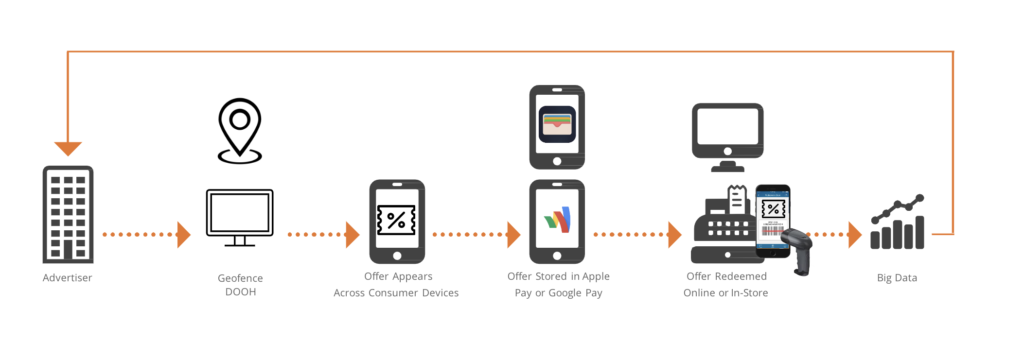
QR codes can be easily embedded into the campaign’s creatives. Once campaigns are live, advertisers can access real-time campaign performance data like total unique devices that have scanned codes, number of impressions, total number of QR code scans, and number of offers redeemed. Peak engagement times can also be tracked to give insight into when and how consumers are interacting with a brand.
Stay top-of-mind by continuously reconnecting with consumers
Incorporating QR codes into OOH campaigns has many benefits for both consumers and advertisers. For brands and agencies, different messaging can be displayed based on factors like time of day or a viewer’s location. This helps to extend the brand’s reach and marketing efforts to new locations, like retail environments, which can help drive sales and foot traffic. When a consumer enters an activated area, they can automatically be prompted with specific notifications and messaging, helping advertisers create an ongoing personalized experience.
Advertisers can also track every interaction and collect data in real-time to create targeted and contextual messaging. Enabling push notifications that deliver additional offers based on the campaign puts the brand in a top-of-mind position for the consumer. QR code-based offers can also help increase digital ad effectiveness by driving brand awareness and interaction without overexposing the consumer to ads. Campaigns can be optimized by A/B testing different offers and messaging in real-time, helping to close the sales loop and prove media marketing attribution.
Increase customer engagement across an entire campaign
The CPG and Retail industries are already familiar with the use of QR codes, though they’re way more prominent today than they were in the past. Many of the world’s biggest brands and retailers incorporate QR codes into their OOH campaigns to connect with consumers while helping drive impressions.
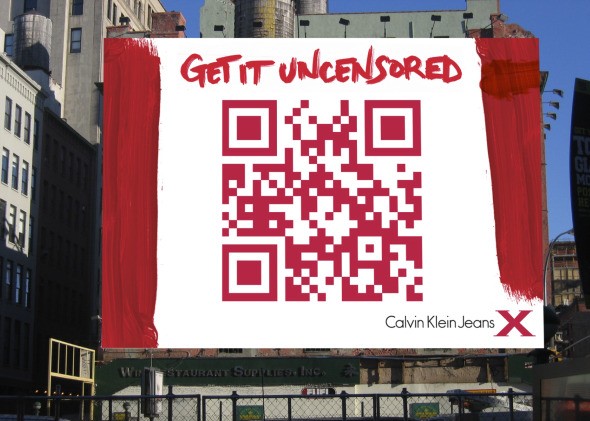

Let’s take a look at an example of an alcohol brand that launched a QR code activation campaign to promote its proprietary wine. The campaign ran across 12,000 screens in the US in 1600 building lobbies and elevators for a 2 month period, resulting in over 16 million impressions per month. When scanned, the brand’s QR offer displayed various bottles and wine packs in different sizes and prices ranges. Measurable data collected from this campaign showed a 10% week-to-week increase in customer engagement throughout the duration of the campaign.
Changing an ad’s call-to-action to a QR code can also help increase engagement, even if there is no promotion attached to the campaign. A cinema media company recently conducted a test with a popular movie release to measure the engagement of a QR code versus a vanity URL or text-to-screen CTA. They placed a dynamic QR code on-screen and invited viewers to scan it to unlock a short clip with additional content. The QR code was found to pull 6x more engagement than a vanity URL and 3x more than text-to-screen. For a moviegoer, scanning a QR code is easier and faster as most people have their cell phones with them during previews. For brands and advertisers, simply changing an OOH ad’s CTA from a URL or a 1-800 number can help yield big results in terms of engagement while also allowing them to reach larger and wider audiences.
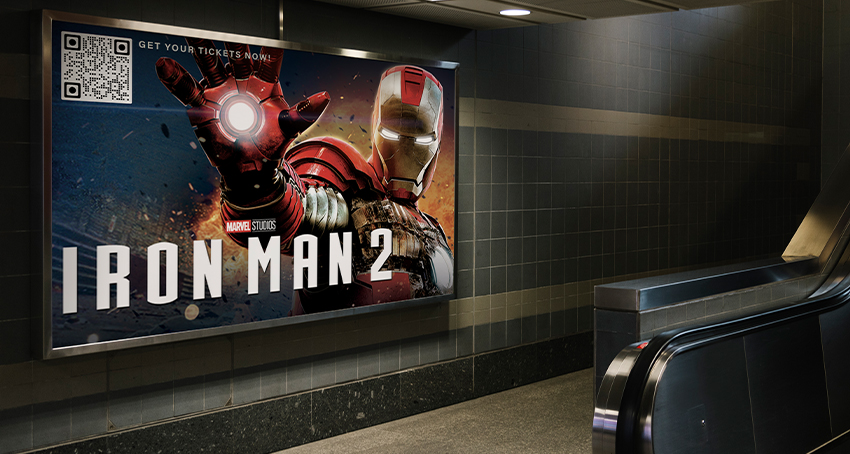
QR codes pull 6x more engagement than a vanity URL and 3x more than text-to-screen.
Making the comparison between different types of CTAs is critical for marketers and advertisers in evaluating the success of a campaign when it comes to measuring engagement levels. While QR codes can help drive sales or foot traffic, it can be difficult to attribute them to total consumer spend as it ultimately comes down to how good the offer is. If the goal is to drive engagement or create a unique brand experience, QR codes are a great option to turn any campaign into an interactive one.
To learn more about incorporating QR codes into your Campsite campaign, book a call with one of our experts.
Comment l’entreprise D2C Cook it utilise Campsite pour ses campagnes d’affichage numérique contextuelles
Pour Cook it, cuisiner des repas faciles et de haute qualité à la maison devrait être amusant et accessible. Fondé en 2014 par la montréalaise Judith Fetzer et ses partenaires, Cook it a été pionnier de la boîte repas au Canada et est aujourd’hui l’un des plus grands fournisseurs de repas prêts-à-cuisiner du pays. La mission de l’entreprise est de ramener le plaisir de cuisiner dans les foyers canadiens en diminuant le temps de préparation tout en éliminant le stress de la planification des repas.
Après avoir transitionné vers un modèle d’abonnement en 2016, Fetzer a continué à trouver le succès dans le marché des kits de repas lorsqu’elle a signé une entente avec des investisseurs sur Dragon’s Den en 2017. L’entreprise a ensuite acquis son concurrent Kuisto, puis Miss Fresh en 2019. En 2020, la pandémie a provoqué une croissance exponentielle pour Cook it. Entre les fermetures et l’augmentation des achats d’épicerie en ligne, ils ont embauché plus de 600 travailleurs pour répondre à l’augmentation de la demande. Aujourd’hui, l’entreprise compte plus de 700 employés. Le 2 décembre 2021, ils ont annoncé leur acquisition des actifs de la société de repas prêts à consommer Locaal.
Avec des efforts continus pour être plus écologique, Cook it s’engage envers l’environnement avec des initiatives comme la réduction du gaspillage alimentaire, l’approvisionnement durable, et l’encouragement d’un mode de vie végétarien. Ils s’investissent également dans la croissance économique du Québec en travaillant avec des chefs, des producteurs d’aliments et des entreprises locales.
Cook it comprend l’importance d’une stratégie de marketing diversifiée étant donné sa part croissante du marché des kits repas. Nous avons récemment rencontré Alexandre Cholette, responsable des placements média chez Cook it, pour en savoir plus sur leur partenariat avec une émission de télévision québécoise et comment ils ont créé des campagnes d’affichage numériques avec Campsite.
Le marché des boîte repas
Avec l’augmentation du commerce en ligne, les consommateurs ont changé leur façon d’acheter, de préparer et de consommer leurs repas au cours des dernières années. La démographie des boîtes repas s’est élargie au-delà des jeunes professionnels et des foodies pour inclure les familles actives. Cook it a répondu à cette demande en attirant les familles canadiennes avec des recettes rapides et pratiques et des repas prêts à consommer. Grâce à leur approche personnalisée de la planification des repas, les clients peuvent modifier les boîtes selon leurs préférences, ce qui permet à l’entreprise de recueillir des informations qui peuvent ensuite être utilisées pour le marketing.
L’équipe de marketing de Cook it met l’accent sur une approche ciblée et rentable. Ils veulent que leurs boîtes de repas soient aussi abordables que possible pour le client. Ils tentent donc d’être le plus stratégique et efficace possible dans l’utilisation de leur budget.
Avec une telle concurrence entre les services de kits de repas, dont beaucoup reposent sur le marketing avec des coupons et des tactiques de remise, Cook it se concentre sur l’atteinte de publics spécifiques qui apprécient et consomment activement des boîtes de repas, plutôt que de cibler les chasseurs d’offres.
Améliorer l’efficacité des campagnes omnicanales grâce à l’affichage numérique affiné
Pour créer de l’enthousiasme et faire connaître ses boîtes repas, Cook it s’est associé à la série de télé-réalité québécoise Occupation Double pour offrir les repas des candidats chaque semaine. Grâce à ce partenariat, les abonnés de Cook it pouvaient sélectionner les mêmes recettes que leurs candidats préférés et cuisiner les plats à la maison. Avec des campagnes d’affichage correspondantes à travers la province, Cook it a fait la promotion de ses recettes en utilisant des annonces basées sur ce qui se passait dans l’émission.
Avec cette campagne, l’objectif de Cook it était d’atteindre le public cible grâce à des publicités contextuelles qui créaient une connexion avec chaque épisode. Les affichages étaient modifiés chaque semaine pour adapter le message autour de l’émission, ce qui contribue à créer un rappel de la marque tout en offrant un aperçu des recettes de chaque semaine.

Avec un mix multicanal qui inclut la télévision, la radio et le numérique, les campagnes d’affichage de Cook it ont touché environ 3,000,000 de personnes de manière créative et marquante . Les campagnes ont été affichées sur environ 300 écrans numériques extérieurs, notamment des panneaux urbains, des abribus et des panneaux d’affichage dans 24 zones géographiques à travers la province. Avec des dizaines de milliers d’annonces diffusées pendant la durée de la campagne, Cook it a pu atteindre une variété de démographies, donnant ainsi lieu à des millions d’impressions.
Ils ont même utilisé l’affichage pour promouvoir leur Classe de maîtres, un service exclusif qui permet aux abonnés de préparer à la maison des repas gastronomiques créés par des chefs en suivant des classes virtuelles.
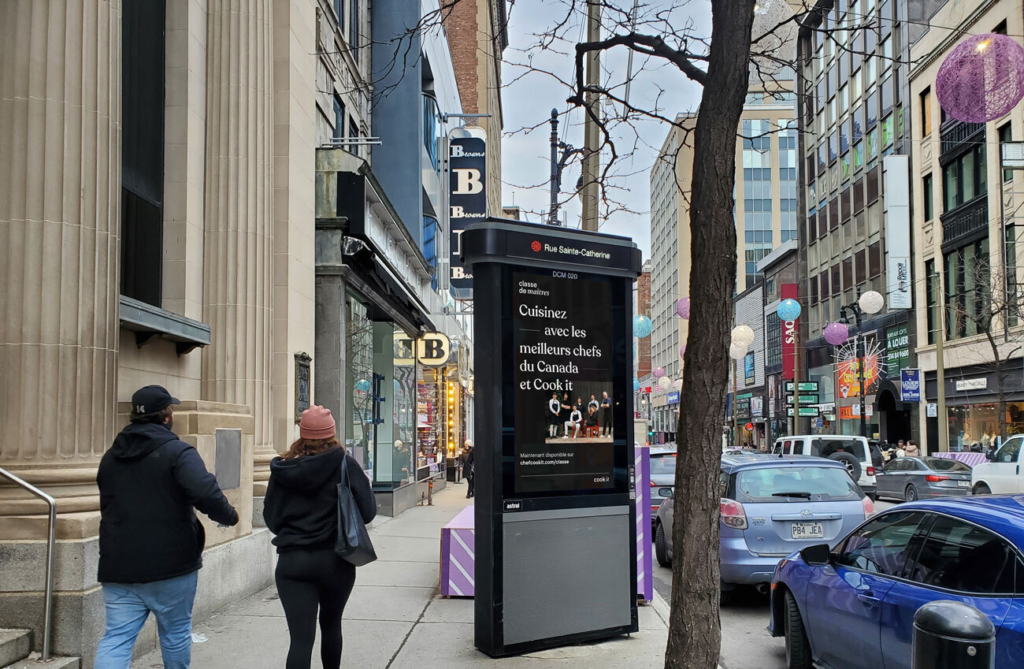
La différence grâce à Campsite
Avec Campsite, Cook it était en mesure de changer et adapter rapidement leur contenu selon des facteurs comme les changements de recettes ou les émissions de télé-réalité pour créer des messages contextuellement pertinents qui ont permis de renforcer le rappel des publicités. Selon Alexandre, la facilité d’utilisation et la fonctionnalité de Campsite ont rendu la plateforme particulièrement bénéfique et efficace pour l’équipe de marketing.
De l’imagerie aux horaires spécifiques en passant par la résolution d’écrans, l’équipe de Cook it a été capable de facilement programmer les campagnes hebdomadaires en quelques minutes. L’équipe de Campsite a contribué à une exécution sans faille qui a aidé Alexandre et son équipe à optimiser les résultats de leur campagne.
“Ce qui prenait des heures à planifier et à exécuter a été réduit à quelques minutes avec Campsite. La facilité d’utilisation, qui imite les plateformes d’achat de publicité en ligne, et ses fonctionnalités de ciblage et de programmation ont changé la donne pour nous.”
Alexandre Cholette, responsable des placements média chez Cook it
Lancer des campagnes d’affichage créatives et contextuelles avec Campsite
Ouvrez un compte Campsite gratuit ou prenez rendez-vous avec l’un de nos experts pour planifier votre prochaine campagne.

